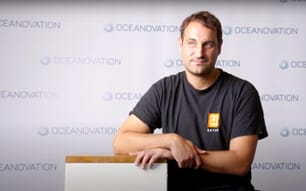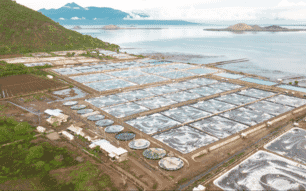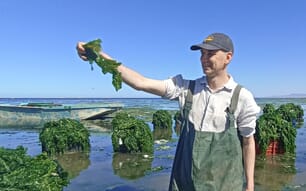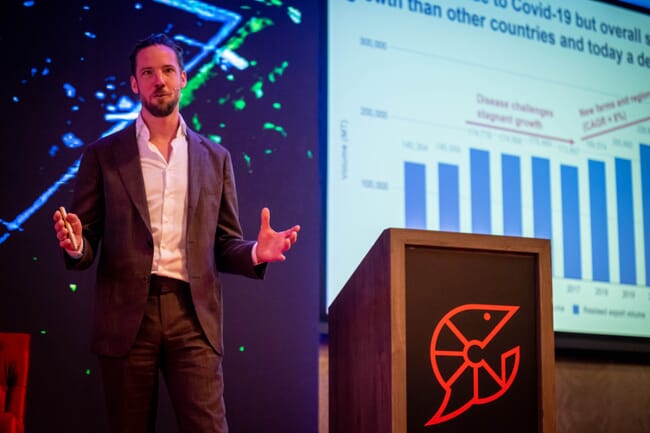
This year saw the second edition of the Global Shrimp Forum, which took place in Utrecht at the beginning of September © Pierre Banoori Photography
van der Pijl, who is the managing director of the Global Shrimp Forum and owner of Shrimp Insights, reflects that pivotal events of 2023 include the formation of the Global Shrimp Council – a trade body established with the goal of increasing demand for shrimp around the world, with an initial focus on the US market.
One event that van der Pijl is particularly proud of – and which he helped to broker – was the agreement between a number of key players across the shrimp value chain to promote the development of more sustainable feeds and improve shrimp welfare.
The deal involves a consortium and will result in Albert Heijn, the Netherlands’ largest retailer, selling shrimp farmed by Cofimar, in Ecuador, according to strict standards.
“The core elements in the project involves feed and animal welfare. In the feed we are replacing 15 percent of the fishmeal with insect meal produced by Protix; we’re replacing 30 percent of the fish oil with Veramaris’s algae oil; and the remaining fishmeal and oil is coming from processing byproducts and from a Marin Trust-certified fishery in Ecuador. That combination will bring the FIFO and FFDR very close to zero. Meanwhile the soy content in the feed will come from low risk origin producers not connected with deforestation or land conversion. So all the soy comes from the US,” he explains.
“Meanwhile, in terms of animal welfare the main focus is on not ablating the female broodstock meaning that we have co-operation with two hatcheries that guarantee us – through the implementation of DNA traceback technology – that the females that produce the PLs for this project are not ablated,” he adds.
The project will initially produce 1,000 tonnes of shrimp that are grown according to these standards and the first of these shrimp will be available in Albert Heijn in February or March of 2024. And there’s scope for that to double, according to van der Pijl.
“We are actively working to expand the project to other supermarkets too,” he explains.
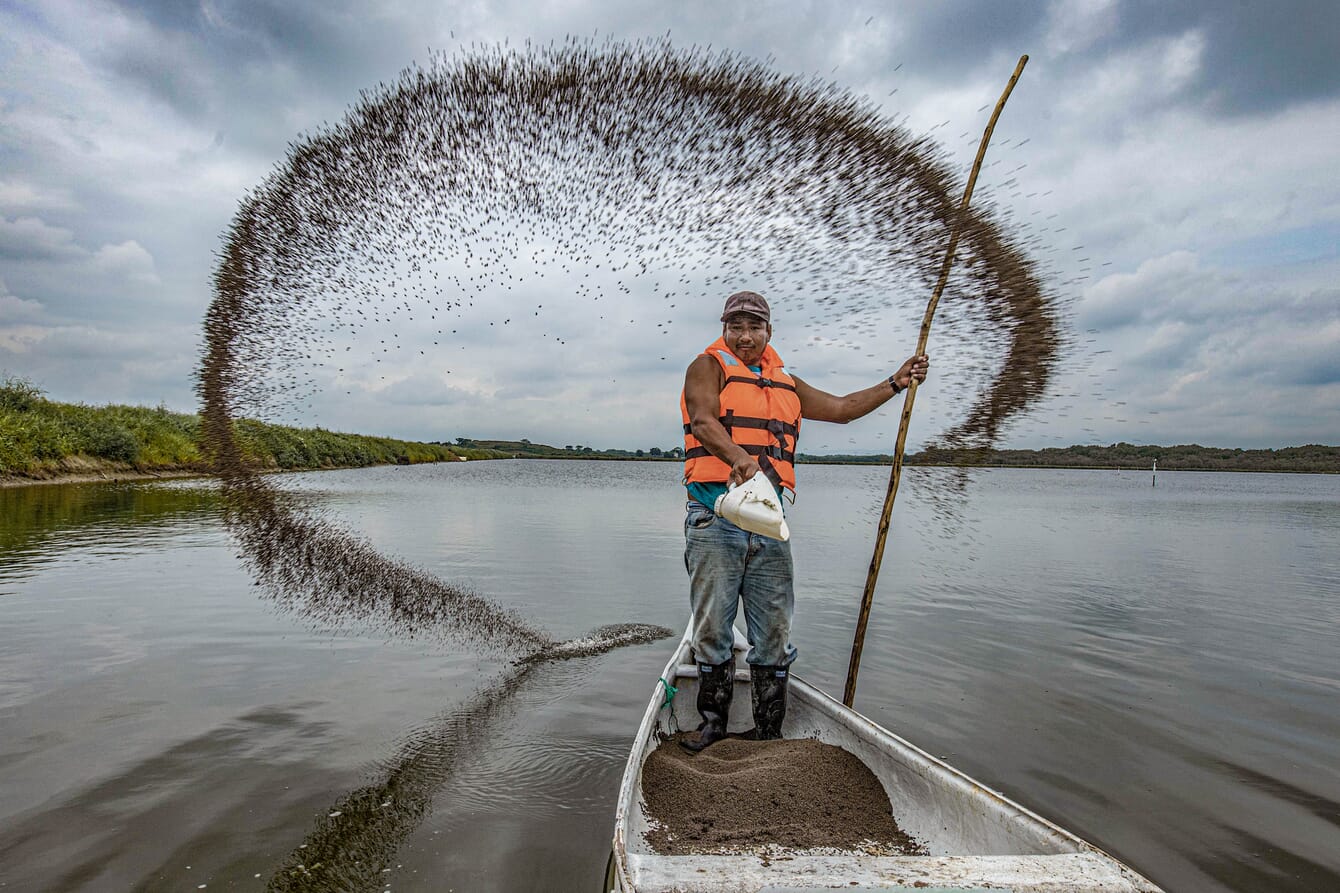
van der Pijl helped broker a deal between a number of key players across the shrimp value chain to promote the development of more sustainable feeds © SSP
However, this will depend on the success of the pilot project – which relies on it proving workable and economical for Cofimar.
“The main challenge is to show that Cofimar that all the investment that they have to make. They are taking the risk by changing their way of working into a dedicated supply chain – with dedicated ponds, with dedicated feed, dedicated PL suppliers – which requires a lot of loyalty between all the different players. It has an impact on the way they do their business – under normal circumstances they can switch suppliers quite easily, but it’s not possible in this project as they need to support all the claims made along the value chain. So they all have to be loyal to each other. The most difficult part is to work out how to ensure that they still have competitive products in the market that can be scaled. You can’t place yourself too far beyond the competition,” he explains.
“The main change is that they have to go from spot prices to a cost-plus model. This reduces your volatility and means that you can sometimes be above, and sometimes below, the spot market price. It’s not a fixed premium – it all depends on the difference between the two prices. At the moment, with low market prices the premium is higher, but if prices recover or the producer becomes more efficient then the price difference will change. The only way these projects can work is on a cost-plus model: you can not expect a producer to agree to such a proposition if they are not sure that they are getting paid for it. Otherwise they are better off sticking to their normal system,” he adds.
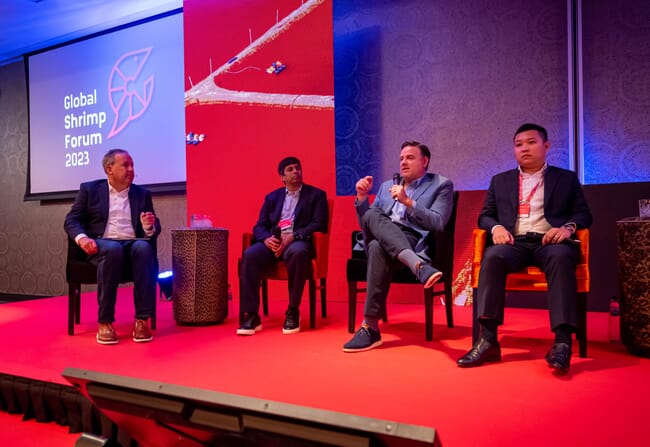
The Global Shrimp Council – a shrimp promotion initiative devised by Luna and David Custo – was launched at this year's Global Shrimp Forum © Pierre Banoori Photography
GSF success
The second edition of the Global Shrimp Forum was another highlight of 2023, according to van der Pijl.
“We went slightly bigger this year – we had more than 500 people, from over 35 countries and 250 companies. It was a true leadership event and we had the top executives from most of the shrimp industry's largest shrimp producers, feed companies, importers, supermarkets from around the world,” he reflects.
van der Pijl notes that the event was a success despite the atmosphere contrasting sharply from its predecessor.
“During the first event we were just coming out of Covid, the industry was doing pretty well, shrimp prices were quite high, volumes were growing and people were making really good profits. This time people were in a painful position because volumes continue to grow but prices are down because of the contraction in demand,” he reflects.
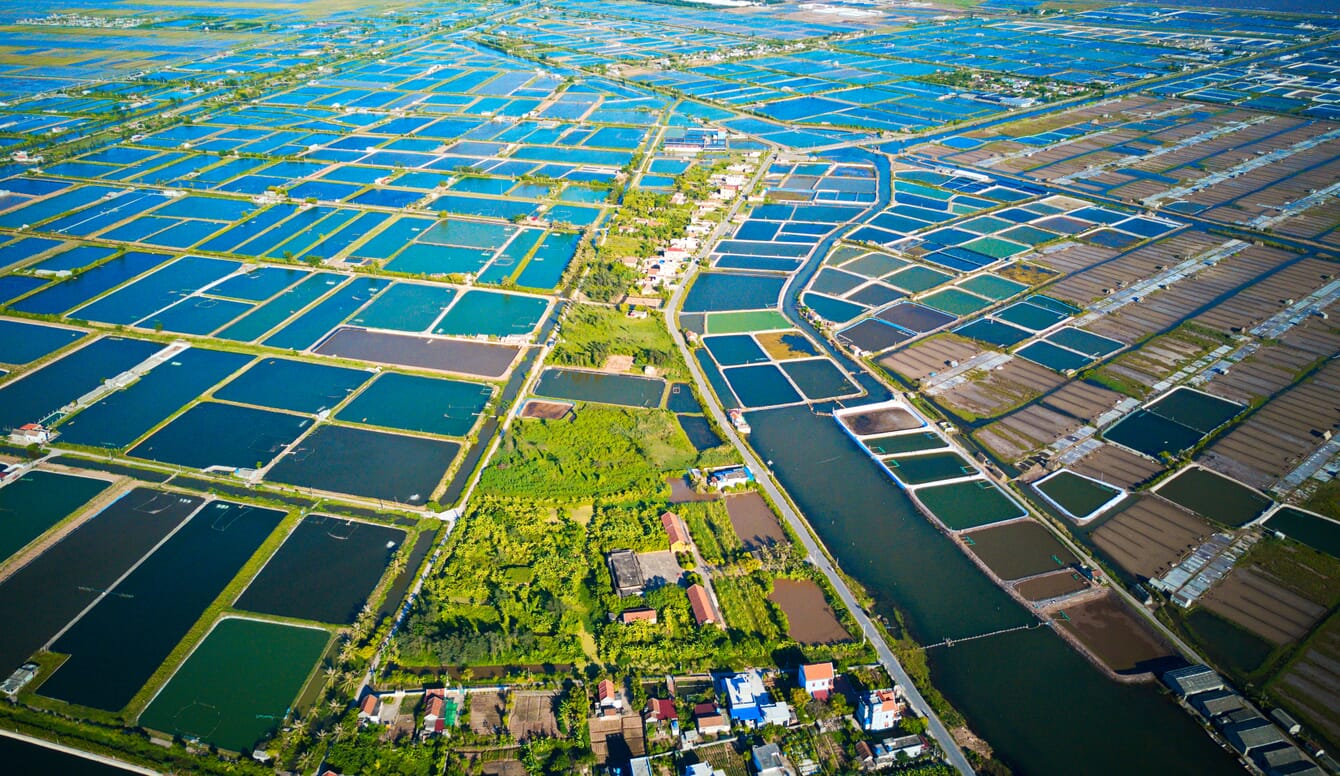
According to van der Pijl, shrimp volumes in Indonesia and Vietnam are going down, whereas in Ecuador volumes continue to grow and in India they remain stable © Shutterstock
“So, logically the two most important themes for this year’s conference were: 1) how can we grow consumer demand for sustainable shrimp and 2) how can we be more efficient and reduce production costs so that we are able to deal with lower price levels,” he adds.
According to van der Pijl, one of the defining moments of the forum was the launch of the Global Shrimp Council – a shrimp promotion initiative devised by Gabriel Luna and David Custo, which has attracted 22 founding companies from across the shrimp producing regions – including seven from Ecuador, seven from India and the rest from across Asia.
It’s an initiative that van der Pijl is fully committed to. And it helped inspire the Global Shrimp Forum Foundation to commission a report on how and why shrimp consumption should be promoted, the results of which have just been published. One of the key recommendations of the report is the value of initially focusing on the US market – a recommendation that mirrors the council’s approach.
The bigger picture
Looking at broader trends in the shrimp sector, van der Pijl expects 2024 to be another challenging year for many.
“In terms of volumes Ecuador continues to grow, India remains stable, Indonesia and Vietnam are going down. While there is likely to be an overall growth in volume, this isn’t something that should be interpreted as good for the industry – if prices continue to go down it will lead to greater consolidation. You can already see fundamental changes happening in some places due to consolidation – in Ecuador there’s an extremely fast rate of consolidation – and the need for more efficiency: producers who can’t consolidate and therefore have smaller margins and producers who cannot become more efficient will face an incredibly hard time in 2024,” he predicts.
Meanwhile the big players continue to grow their volumes.
“In Ecuador it’s pretty clear that companies like Omarsa, Songa and Santa Priscilla are growing their volumes incredibly fast. And there are some positive things happening as the sector enters a new phase of maturity – there’s been a huge growth in amount of finance and number of investors, who previously perceived it as too risky or too small, who are now looking at the shrimp industry,” he notes.
“I think volumes will continue to grow, but at a lower rate than in previous years. While I’m pessimistic about prices. If the volumes continue to grow it’s very unlikely that prices will recover, as we’re still in an oversupply situation,” he adds.
However he predicts that some companies will be better placed to deal with this than others.
“It’s a mistake to think of countries competing with each other. In reality, in each country there will be winners and losers. While a lot of farmers are suffering in India, for example, some companies are – like Devi Seafoods and Avanti – are growing because they have a strategy that allows them to survive the new climate that the industry has to deal with. Long-term partnerships with the largest US retailers and food service companies won’t suddenly shift from India to Ecuador, because of the steady relationships they have. And, within Asia, India has the lowest production costs, so is in the second strongest position,” van der Pijl notes.
“The leading players in India are resilient and do have time to reconsider the ways they are dong their business and make sure they can compete with Ecuador for those clients they have had for so long,” he adds.
Another trend in India, notes van der Pijl, is the investment in value-added processing – with a huge rise in the production of breading factories.
“Breaded shrimp is an attractive market in India because it’s not included in anti-dumping tariffs in the US. It used to be huge in China, but they were hit by the anti-dumping legislation. Vietnam and Indonesia took over. But now India has realised that they can outcompete the others as their labour and shrimp are much cheaper,” he explains.
However, this is likely to be different in higher cost countries.
“In Vietnam and Indonesia probably only the farms that can innovate will thrive, while smaller scale farms that can’t improve their efficiency will have a really hard time because production costs are higher than in India and Ecuador,” he adds.
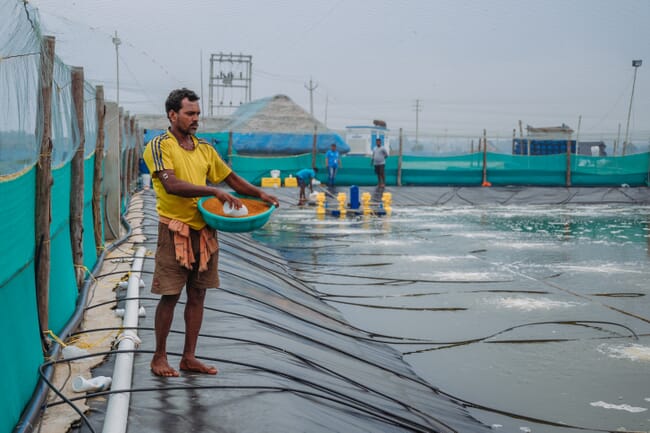
van der Pijl has been commissioned to produce a 150-page guide to the whole value chain of the Indian shrimp sector
Personal plans
From a personal perspective van der Pijl expects a busy 2024, not least because he’s been commissioned to compile a 150-page guide to the whole value chain of the Indian shrimp sector early in the year.
“My main aim is to help the Indian shrimp industry show to the world that it has a huge impact on the country’s economy and the on the livelihoods of hundreds and thousands of people along the value chain. I hope it helps people better understand the sector’s structure and dynamics. And to also show the beauty of a sector that employs 150,000 farmers,” he explains.
“I hope that people engaged in shrimp around the world will read it and it will become a reference work that the Indian industry can use,” he adds.
He is also looking forward to the third instalment of the Global Shrimp Forum, which will take place in Utrecht in September.
“It’s going to be a busy – but hopefully rewarding – year,” van der Pijl concludes.


